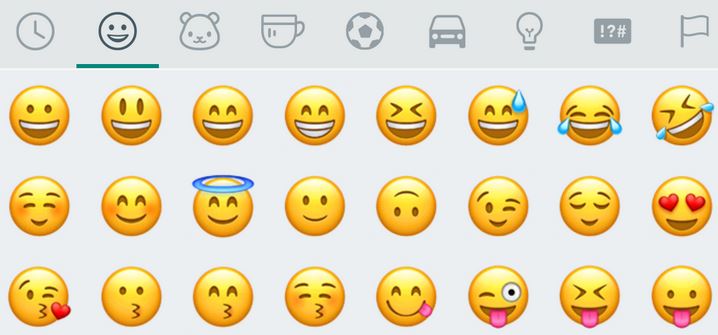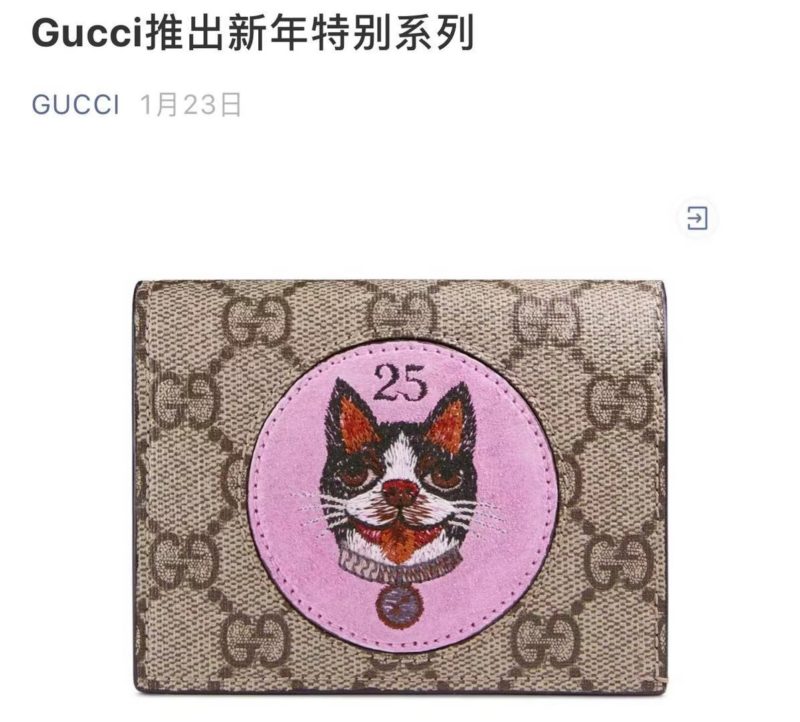Visually driven communication as a part of Chinese consumers daily online conversation
Global consumers spend a significant amount of time on social media and instant message application. 95% of internet users have sent an emoji at some point and over 10 billion emojis are sent each day. Emojis and stickers in chatting apps are becoming a crucial part of our online language and even a part of our culture. The netizens are using this specific “language” communicating with each other and having fun at the same time. Chinese netizens are no exception, especially Chinese millennials. As a matter of fact, due to discouraging of outward expression of feelings and attitudes, as well as the preference for an obscure sense of humor, Chinese users are even more enthusiastic about so-called 表情包 (biao qing bao=facial expression pack, Chinese for stickers pack used on messaging applications). It has become an unabandoned part of Chinese consumers’ daily conversation.
It is not new for international companies to leverage branded emojis and stickers in chatting apps to engage with their potential or existing consumers. It seems to be a perfect strategy infiltrating Chinese millennials’ daily life. Branded emojis and stickers in China are supposed to help improving brand awareness and loyalty among consumers; yet before jumping onto this bus, international enterprises need to be clear with such 5 following points:
1. Tricks of the Chinese online business environment: Emojis VS Stickers
Emoji are pictographs (pictorial symbols) that are typically presented in a colorful cartoon form and used inline in the text. They represent things such as faces, weather, vehicles, buildings, food and drink, animals and plants; or icons that represent emotions, feelings, or activities. When you send a sticker to someone in a text message, in fact, you’re sending them a file (PNG, JPG, or GIF). Generally, stickers in China are customizable and usually contain more information.
|
|
Stickers more popular than emojis in China. Because, first of all, emojis are considered ‘unhandy’ by many Chinese consumers. Users feel troubled by having to download the branded-emoji-keyboard outside of a messaging app. On the other hand, stickers, especially animated ones (dongtaibiaoqing 动态表情, saved as a GIF file), are more dramatic, which allow introvert Chinese people to express themselves without saying the words directly. As a result, stickers in China are more popular among consumers’ online messaging, while emojis appear more frequently in social media posts because of its smaller size.
For international brands, it is very important to take this into consideration and utilize branded stickers as a tool for their Chinese marketing campaign.
2. Chinese netizens preferences: What platform should be used for launching branded emojis and stickers?
iPhone users might have noticed of the new feature of an iOS operating system: downloaded applications on your iPhone will automatically show under the input field of iMessage. Some apps have their own stickers, which can be sent directly by an iMessage. Although it is convenient for iPhone users, this branded emojis and stickers probably miss out the whole Chinese market. Here are the reasons:
a) The statistic shows that in December 2017, Android held a share of 78.69 percent of the mobile operating system market in China.
b) Chinese netizens prefer downloading stickers pack directly from WeChat Sticker Gallery within WeChat, which is a multi-purpose messaging, social media and mobile payment app developed by Tencent. According to Business Insider: “83% of all smartphone users in China use WeChat, 93% in China’s Tier-1 cities. Chinese smartphone users rarely use iMessage to communicate with each other, especially the younger generation”. Additionally, branded emojis and stickers downloaded from App Store and Google Play Store cannot be used on WeChat, which makes them almost useless for Chinese consumers.
China No.1 recipe-sharing and ingredients-purchasing application Xiachufang have their own stickers on iMessage, but it is most likely unknown for the major part of Chinese Xiachufang users. On the other hand, it might be crucial for Chinese local brands, who want to go global.

3. What is the main purpose of releasing branded emojis and stickers in chatting apps for a brand in the Chinese market?
Branded emojis and stickers from brands in China can be used for many different purposes. For example, product promotion, brand image transmitting, internal branding and so on. Before creating branded emojis or stickers for the Chinese market, international brands need to know their specific goal for the design.
In March 2015, Burger King reintroduced Chicken Fries in response to the outcry in social media about the product’s removal from the menu. Burger King celebrated the return of chicken fries to its menu by launching a BK chicken-fries-themed emoji keyboard. AdAge awarded Burger King as one of the top ten emoji campaigns in 2015, according to a study conducted. After engaging with Chicken Fries content in mobile messaging Gen-Z and Millennials were:
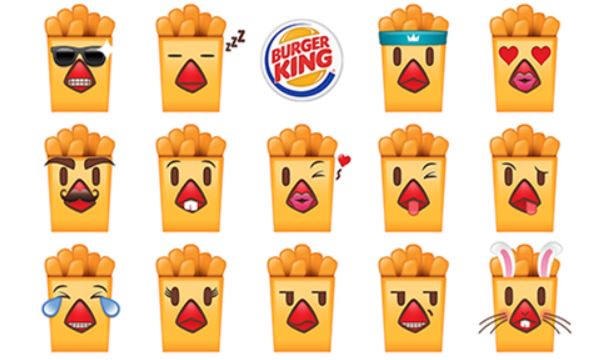
- 55% more favorable towards Chicken Fries;
- 39% more likely to purchase Chicken Fries;
- 36% more likely to recommend Chicken Fries to a friend.
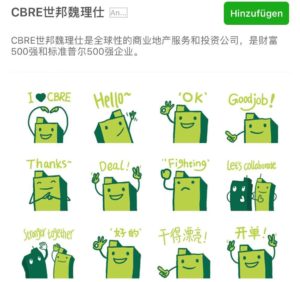
Another example is from CBRE, whose branded sticker pack on WeChat are obviously designed for their own employees and business partners to use. The purpose of the branded-stickers is to convey the company’s spirit and core culture.
This commercial real estate services and investment firm from the US created these stickers speaking both English and Chinese conveying company’s core spirit e.g. “Stronger together” and “Fighting”. The stickers pack can be easily found in the WeChat Sticker Gallery by searching for the keyword: CBRE.
4. Who is the target audience for the branded emojis or stickers?

Once consumers identify themselves with the emojis and stickers in chatting apps, they are much more likely to share them with family and friends in their digital conversation. Since Dove realized that there was no wave-haired emojis, they created an emoji keyboard in 2015 with curly-haired women, which really filled the market blank and offers curly-haired female consumers emojis which they can relate to. As a matter of fact, launching the Dove-Love-Your-Curls Emoji Keyboard was a part of Dove’s marketing campaign for Dove Quench products for women with naturally curly hair. In this way, the target group, in this case, curly haired women felt immediately connected with this brand, which enhances the awareness of the new product and strengthens the brand loyalty.
5. What content Chinese consumers like to include in their online conversation?
Instant messaging is one of the most intimate online communication, in which Chinese share lots of content with friends and family, especially among teens and young adults. This target group is technique-savvy, sensitive to trends and hot topics. It might be smart to integrate buzzwords into branded emojis or stickers. Companies should also aware of the millennials’ “talking” habits and the communication culture in China. For example, among Chinese teens and young adults, the culture of Meng is quite dominant, companies could utilize the cuteness while designing their emojis and stickers in chatting apps. A good example is the Disney princess-themed WeChat stickers pack, which include several well-known princesses. However, the characters are super deformed caricatures, so that they appear more adorable and suit the Chinese young generation’s taste better.
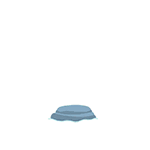 |  |  |  |
Infiltrating into consumers’ daily conversation using emojis and stickers in chatting apps, by including buzzwords or current popular phrases among Chinese young people, is a smart strategy. However, international brands should be aware that trying too hard to be down with young Chinese consumers might appear pathetic and embarrassing to the target audience; as a result, people won’t use these branded emojis or stickers.
Successful cases using branded stickers in China
Tencent doesn’t allow companies publishing emojis and stickers with obvious advertising or promotion content on its platforms (WeChat, QQ). Brands intent to reach Chinese consumers on these messaging apps have two options:
- Launching branded stickers in China without logo and brand/product information directly on WeChat Sticker Gallery
An excellent case is the Starbucks “用咖啡干杯 (Cheers to Coffee)” stickers pack launched in December 2017. At the same time, Starbucks China official WeChat account published an article to promote this stickers pack. Although these stickers have no Starbucks name nor logo on them, due to the color and shape of the coffee cup, it is good recognizable for Chinese consumers. Starbucks targets the middle- and high-end market in China. The main target audience in China is trendy young white-collar workers. They are holding strong consumption capacity, yet lead busy lives and willing to spend a bit more for a premium coffee consumption experience. This stickers pack consists 24 stickers covering a typical day of a young Chinese white-collar. Consumers can relate themselves to the stickers from brands in China. Moreover, because there is no obvious advertising content in the stickers, they might be accepted more easily by consumers.
 |  | 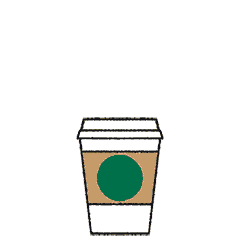 |  |
“but first, coffee”, “meeting”, “well done” and “I’m leaving”

Cheers to Coffee stickers pack on WeChat Sticker Gallery (right)
- Releasing branded stickers NOT directly on WeChat Sticker Gallery, but within WeChat posts, allowing consumers to add into their WeChat sticker collection.
A good example from Mc Donald: its official WeChat account posted in March 2018 an article promoting a new beverage collection. The GIF images within the WeChat post can be easily saved as users’ personal stickers. This branded stickers pack from Mc Donald successfully gets the attention from lower to middle-class consumers in China. This group of consumers are sometimes frustrated and have lots of pressure from their working and personal life. These stickers precisely point out their stress and “embarrassments”, at the same time, allow these people to make fun of their situation by sharing stickers with friends.


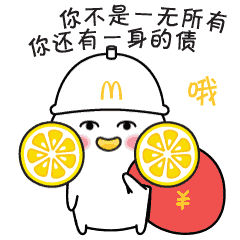
“Others get more salary, you get more extra shift” (left)
“It’s not true that you have nothing, you have lots of bills to pay” (right)
Luxury brands have stepped down from the throne and connected with Chinese consumers by means of branded stickers
While international luxury brands’ official WeChat posts usually contain perfect visuals and finely tuned writing, they rarely capture the reader’s desire to “share”. It might appear a bit dangerous to humble themselves and publish humorous or cute stickers for Chinese consumers. However, consider that Chinese netizens have made their own version of luxury branded stickers, implies that Chinese consumers are willing to include their beloved brands into their online conversation. Since people are having fun sharing these “branded stickers” of luxury brands anyway, why shouldn’t international brands create some branded stickers for their own?
On Jan. 23rd 2018, just before the Chinese New Year, official Gucci China WeChat account published an article shouting out for their new puppy-themed products including handbag, wallet, smartphone case, etc. The dogs on Gucci’s Lunar New Year special collection are based on Gucci’s creative director Alessandro Michele’s own Boston terriers, Bosco and Orso. Within this post, Gucci released a set of branded stickers celebrating the year of the dog. These branded stickers are well balanced between product and brand promotion and adorable puppy image with funny messages in Chinese, presenting Gucci’s fans in China the opportunity to chat with their friends and family using stickers of their beloved brand, at the same time, spreading new year happiness wishes.
|
|

Takeaways for international companies willing to leverage branded stickers in China
Emojis and stickers have become an essential part of the online conversation around the world and they have changed the way teens and young generation interacts with each other. One image says more than a thousand words and it helps to lighten the mood making communication online more exciting and fun. How can international brands leverage this tool to integrate into Chinese consumers’ daily life? Here are the takeaways from Daxue Consulting:
- Stickers are more popular in China than emojis.
- WeChat is dominant on Chinese online messaging application market. WhatsApp, Snapchat, iMessage are rarely used in China. International companies should rather release their branded emojis and stickers on the platform of WeChat instead of App Store or Google Play Store.
- International brands should be very specific with their goal and target group before creating their branded emojis and stickers. Once consumers can relate themselves to the stickers, it is much more likely they will share them.
- Get familiar with the Chinese millennials’ “talking” habits and the communication culture in China. Include buzzwords or popular phrases into branded stickers might be a clever solution. However, the balance is required, trying too hard to integrate might seem pathetic and drive consumers away.
- WeChat does not allow stickers with obvious promotion and advertising content. Two options for international brands: (1) publishing WeChat post including branded stickers for consumers to download; (2) launching stickers without brand/product name direct on WeChat Stickers Gallery.
- Branded stickers should be well balanced between product and brand promotion and interesting content (e.g. funny message, adorable images), that makes them more acceptable by consumers
- Chinese users are willing to include content from luxury brands into their digital communication, yet most branded emojis from luxury brands only cater to western consumers.
Author: Chencen Zhu
Daxue Consulting regularly helps clients optimize their China business development by offering database building assistance, market research, simple distribution analysis, and SEO. Our staff has strong experience in business development in Shanghai, Beijing, and other tops 50 China’s cities.


